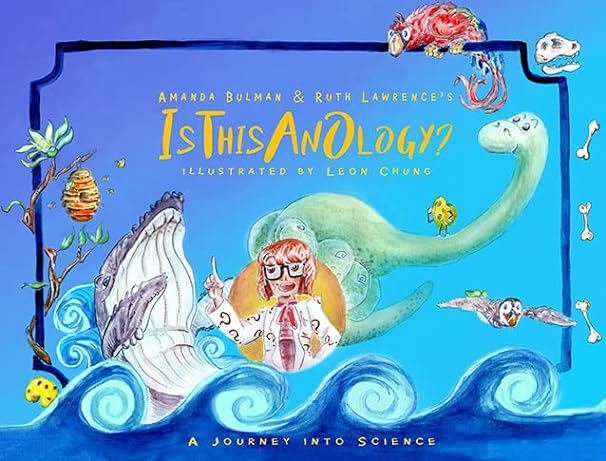IsThisAnOlogy?

IsThisAnOlogy?
Caseology is the study of cheese and cheesemaking! It’s arguable the most delicious of the ologies. While most of our ologies can be found in the dictionary, the word caseology is new and it’s made up of the Latin word for cheese (caseus) and the Greek suffix for a branch of study (logia)! It’s a word used by some people in the food industry. (p. 12)
In nonfiction for a young audience, there is a sweet spot that every author and publisher must aim for, the spot where relatively complex subject matter is presented in an engaging, comprehensive, age-appropriate format.
IsThisAnOlogy? has found that sweet spot and hit it dead on.
The word ology is commonly used to denote a field of study. IsThisAnOlogy? introduces six ologies: ornithology, caseology, geology, marine biology, apiology, and paleontology.
Authors Amanda Busman and Ruth Lawrence use a narrator to introduce readers to each ology. Sometimes the narrator conducts a Q&A with an expert in the specific ology, but other times the information is presented in text, illustrations, and photographs. Young readers may enjoy the Q&A with Shawn Bath, a Cleanupologist. Shawn is a deep-sea diver who decided he had to do something about the trash he swam over every day.
Throughout the book, there are activities for readers to try, such as how to make dinosaur bones, and a seven-step plan and a list of equipment needed to organize a beach clean-up.
Pick a Beach! Shawn Bath says that some beaches are called “collector beaches,” meaning that tides push plastic and ocean garbage onto the shore. A cleanupologist like Shawn can walk along a beach and quickly discover if it needs a clean-up. He observes and looks for garbage. You can do the same! A collector beach is a great one to choose! But you can pick any beach you love and want to clean up. (p. 33)
IsThisAnOlogy? is an excellent nonfiction book taken one step higher by Leon Chung’s art work. It is the perfect combination of colour and humour to enhance the information in IsThisAnOlogy? Five cartoonish birds perch on our narrator in Ornithology. Shakespeare talks to a smelly hunk of cheese in Caseology. The differences between a bumblebee and a honeybee are illustrated beside our narrator wearing a bee antenna hat in Apiology. Young readers will be so engaged by the art, they won’t even notice how much they are learning.
Full colour photographs also add to the content and the interest in each chapter.
In addition, IsThisAnOlogy? contains several helpful organizational features. Coloured circles direct readers to other related parts of the book, encouraging readers to follow their interests rather than the reading the book from page 1 to page 55.
If you want to know more about oceans and the earth we call home, check out the chapter on geology on page 19! (p. 34)
Each chapter has different coloured borders, allowing readers to quickly skip back and forth to the six different ology sections.
IsThisAnOlogy? has Contents, Glossary, and Recommended Reading.
The final sentence in the promotional sheet accompanying this book sums up my evaluation perfectly.
A great resource for young, questioning minds looking to sponge up how the world works.
Dr. Suzanne Pierson tends her Little Free Library in Ontario’s Prince Edward County for the enjoyment of her friends and neighbours of all ages.
